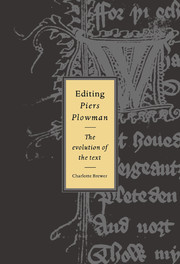Book contents
- Frontmatter
- Contents
- Acknowledgements
- Abbreviations
- Note on the texts
- Introduction
- Part I The early phase
- Part II The late nineteenth century
- Part III The Skeat aftermath
- 10 Manly versus Chambers and Grattan
- 11 Excursus: Westcott and Hort
- Part IV Chambers and Grattan, Knott and Fowler
- Part V The Athlone Press edition
- Part VI Epilogue: the Athlone aftermath: Schmidt, Pearsall, Rigg-Brewer, et al.
- Works cited
- General index
- Index of manuscripts
- CAMBRIDGE STUDIES IN MEDIEVAL LITERATURE
10 - Manly versus Chambers and Grattan
Published online by Cambridge University Press: 20 August 2009
- Frontmatter
- Contents
- Acknowledgements
- Abbreviations
- Note on the texts
- Introduction
- Part I The early phase
- Part II The late nineteenth century
- Part III The Skeat aftermath
- 10 Manly versus Chambers and Grattan
- 11 Excursus: Westcott and Hort
- Part IV Chambers and Grattan, Knott and Fowler
- Part V The Athlone Press edition
- Part VI Epilogue: the Athlone aftermath: Schmidt, Pearsall, Rigg-Brewer, et al.
- Works cited
- General index
- Index of manuscripts
- CAMBRIDGE STUDIES IN MEDIEVAL LITERATURE
Summary
SKEAT'S HYPOTHESES
Far more than previous editors, Skeat grappled with the problem of texts and manuscripts, coming up with various hypotheses that really did seem to supply reasonable explanation for the characteristics of the different manuscripts. He was the first person to show convincingly that there were three main separate versions of the poem, all authorial, which he called A, B, and C. The assumed author, William or Robert Langland, first wrote a short version, A, and then revised and extensively rewrote A to produce B, which was three times A's length. Several years later, so the theory goes, the poet began revising and rewriting B to produce C. Skeat's editions were received with great enthusiasm, and with clear understanding of the outstanding contribution he had made to the establishment and interpretation of the text. What, one might ask, was there left to do?
The answer is, a considerable amount. Several important manuscripts came to light after Skeat published, but even before that, scholars began to debate his position fiercely. And here it is possible to trace some of the characteristics of the way in which theories about texts, and editions themselves, develop.
So far, from Crowley to Whitaker to Wright to Skeat, there seems to be, largely speaking, some progression in textual criticism and editing. Wright is more scholarly and more accurate than Whitaker, and Skeat is superior to both in understanding the importance of consulting as many manuscripts as possible, making informed and shrewd, if not infallible judgements on their relative significance, coming up with the very respectable hypothesis of three original authorial versions as an explanation for the variety and diversity of extant manuscripts, and providing a superb set of notes.
- Type
- Chapter
- Information
- Editing Piers PlowmanThe Evolution of the Text, pp. 181 - 208Publisher: Cambridge University PressPrint publication year: 1996

